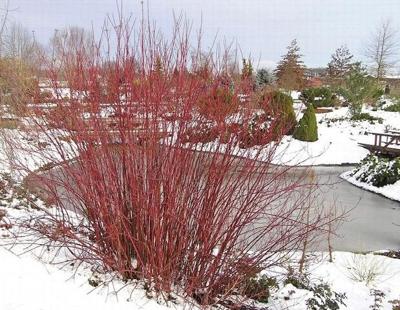It isn’t every day that a plant comes along that will grow just about anywhere and has some interesting feature every season of the year. But that’s just exactly what our northwest native Red Twig Dogwood does. In its native habitat it thrives in moist soil along stream banks and usually in a filtered shade location. Put it in a home landscape and it will grow in sun or shade and wet or dry soil.
Twig dogwoods bear little resemblance to the dogwood tree that is so well known for its white or pink flowers in May. Botanically speaking, both plants are in the same genus but that’s where the similarity stops. While dogwood trees have large flowers and make a small tree, twig dogwoods have creamy white clusters of small flowers and make a medium to large shrub. Those flower clusters turn into beautiful clumps of bluish-white berries in the fall. Twig dogwoods grow about 6 to 8 feet tall and just about as wide. Normally their leaves are dark green during the season, but there are many varieties with variegated foliage and a few with golden yellow leaves. In the fall their foliage turns a brilliant red to orange. Depending on the selection, in the winter the stems of the current season’s growth turn bright shiny red, yellow, or orange. For the best winter color, the stems should be cut down to about 12 inches in the spring.
Of the many varieties on the market, here are four of my favorites:
Midwinter Fire - The name of this variety is perfect. On a bright sunny winter day when the sun is low in the sky and it shines through this plant, it looks like the twigs are on fire. Each individual branch looks like a flame, beginning with red at the base, modulating to orange at the center and terminating with yellow at the tip.
Ivory Halo - This is probably the best green and white variegated variety on the market. Red twigs are clothed with gray-green leaves with irregular shaped white margins. This is a brightly colored plant that is often sheared into hedges, even though it will lose its leaves in the winter. I personally think it looks a lot better if you don’t try to shear it. Let it grow in a natural habit and then cut it back hard in March like I mentioned earlier. With good fall color and great red winter stems, this variety is a definite keeper.
Firedance - According to Bailey Nursery, this new introduction is a “compact variety with white flowers in spring followed by pretty white berries that are attractive to birds. It is tolerant of moist conditions and suitable for rain gardens. The foliage turns a nice red-purple color in fall, giving multi-season interest.” The leaves are solid green and the twigs turn a bright red in winter.
Neon Burst - Also marketed through Bailey Nursery, this new introduction from Bylands Nursery in British Columbia has attractive chartreuse foliage with good sun and heat tolerance, retaining bright leaf color throughout summer. New leaves are tinged with bronze and the stems have a rich red hue early in the season. Fall foliage becomes a rainbow of purple, red, yellow and orange. In winter the stems turn glossy scarlet red.
This is a good time to view and plant twig dogwoods. They are starting to color up in the nurseries so you can get a good taste of their fall and winter interests. Check them out now and find a place for one or two in your garden, you’ll be glad you did. Stay safe and keep on gardening.
Steve Smith is the owner of Sunnyside Nursery in Marysville and can be reached at [email protected].


(0) comments
Welcome to the discussion.
Log In
Keep it Clean. Please avoid obscene, vulgar, lewd, racist or sexually-oriented language.
PLEASE TURN OFF YOUR CAPS LOCK.
Don't Threaten. Threats of harming another person will not be tolerated.
Be Truthful. Don't knowingly lie about anyone or anything.
Be Nice. No racism, sexism or any sort of -ism that is degrading to another person.
Be Proactive. Use the 'Report' link on each comment to let us know of abusive posts.
Share with Us. We'd love to hear eyewitness accounts, the history behind an article.